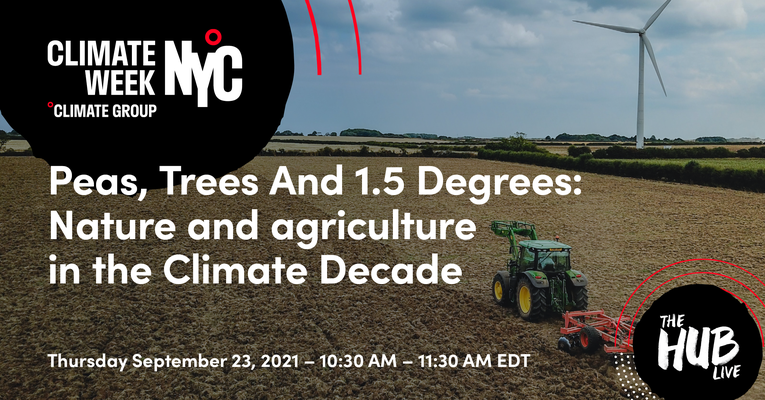From big business to small farmer, we can all work together to help fix our world
This morning’s Climate Week NYC 2021 virtual panel discussion and farmside chat, Peas, trees and 1.5 degrees: nature and agriculture in the Climate Decade, brought together business, government and NGO leaders. They tackled topics around industry and communities working together to build a food system that fights and reacts to climate change. Protecting nature and the economic rights of local farmers were high on the agenda, too.
WWF Peru Director Kurt Holle put it simply: “Produce. Protect. Include.”
The concept of planetary boundaries is critical to the success of businesses
“[Planetary boundaries] was not a phrase that many used or understood until recently, and it's critical that it becomes a part of our everyday language,” said Jim Andrew, CSO, PepsiCo. Planetary boundaries encompass the environmental limits—including global temperature parameters—humanity can safely operate within. “And if we ignore these boundaries,” Andrew continued, “we're going to face disastrous consequences for the health of the planet and the people on it.”
One planetary boundary on the brink was raised by Carolina Genin, climate director of the World Resources Institute Brazil. The Amazon, she said, “has started to be a carbon emitter…[and there] is the possibility of savannization.”
Scientists have found that savannization can occur when a forest loses about 25% of its total coverage, Genin explained. “Our Amazon Forest has already lost 20%.”
Sustainability in the agriculture and land use sector must be a top goal
Ashley Allen, CSO of Oatly, noted that the food sector is responsible for nearly one-third of all global emissions, uses half the habitable land on the planet, along with the lion’s share of its fresh water, and is a massive driver of biodiversity loss. “In short, the food system is broken, and it's really the responsibility of companies to fix that,” said Allen.
Every company in the sector, she added, must take “a look at their full supply chain, their full scope, considering critically how agriculture fits into that scope, and then use that to drive where they're going to take transformative action in the agriculture and land sector.
“That's the only way that we can really solve climate change,” she concluded.
Government should be a positive force for integrating land use, food systems and climate resilience into planning
Seventy percent of India’s population lives in rural areas, making holistic, state-community partnership solutions a must, according to Mudit Kumar Singh, former head of Forest Force, State Government of Chhattisgarh, India. He outlined an innovative project in Chhattisgarh that targeted ranching practices and water and soil treatment, as well as developing individual kitchen gardens to fight malnutrition.
These types of programs, Singh said, “empower people to adapt to climate resilience and inculcate climate-friendly and climate-aware ways of life.”
Some Latin American countries are pioneering sustainable and just green practices
Governor-Prefect, Provincial Government of Pastaza, Ecuador, Jaime Guevara and Governor of Madre de Dios, Peru, Dr. Luis Guillermo Hidalgo Okimura discussed how their governments are implementing plans with similar visions to Chhattisgarh’s.
Guevara outlined four key pillars of his approach:
- Conserve and respect the balance of nature
- Follow the will of rivers
- Create harmony between peoples
- Build sustainable agriculture
Governor Hidalgo Okimura discussed what he called “effective, ambitious and transformative” decarbonization goals that will reduce emissions from agriculture, livestock, forestry and other land uses in his region by 26% by 2030 and 60% by 2050.
Agriculture and the food system link into society’s broader challenges
“The global food system is rooted in agriculture,” Andrew said, and it “presents one of the greatest opportunities to address climate change, biodiversity loss and a vast array of societal issues.”
Rethinking how food is grown using regenerative agriculture practices is key, he noted, but providing farmers with the knowledge and resources they need to put those processes into practice is a must, because farmers are businesspeople.
African Coordinator at Regeneration International, Precious Phiri, spoke specifically to the knowledge and resource challenges on that continent, where smallholder farms account for 80% of food production. Internet access, literacy rates and the pandemic are all significant obstacles. Solutions, she said, must be less technology-intensive and include things like short videos or relatable stories of success from other areas.
Local agricultural producers know what’s needed
Farmers are at the center of solutions, according to Allen. They are on the front lines of climate change and feel its effects directly, no matter where they are in the world. “Companies need to get down and dirty and really work with farmers, work with communities all over the world and really show…[that] regenerative and restorative agriculture can really be a climate solution,” she explained.
The world’s farmers have a message for us
Phiri wants to present possibilities for the future with the human species as part of the solution and have people think from a mindset of abundance, not of scarcity. “When we look at our land, we look at it with love,” she said.
